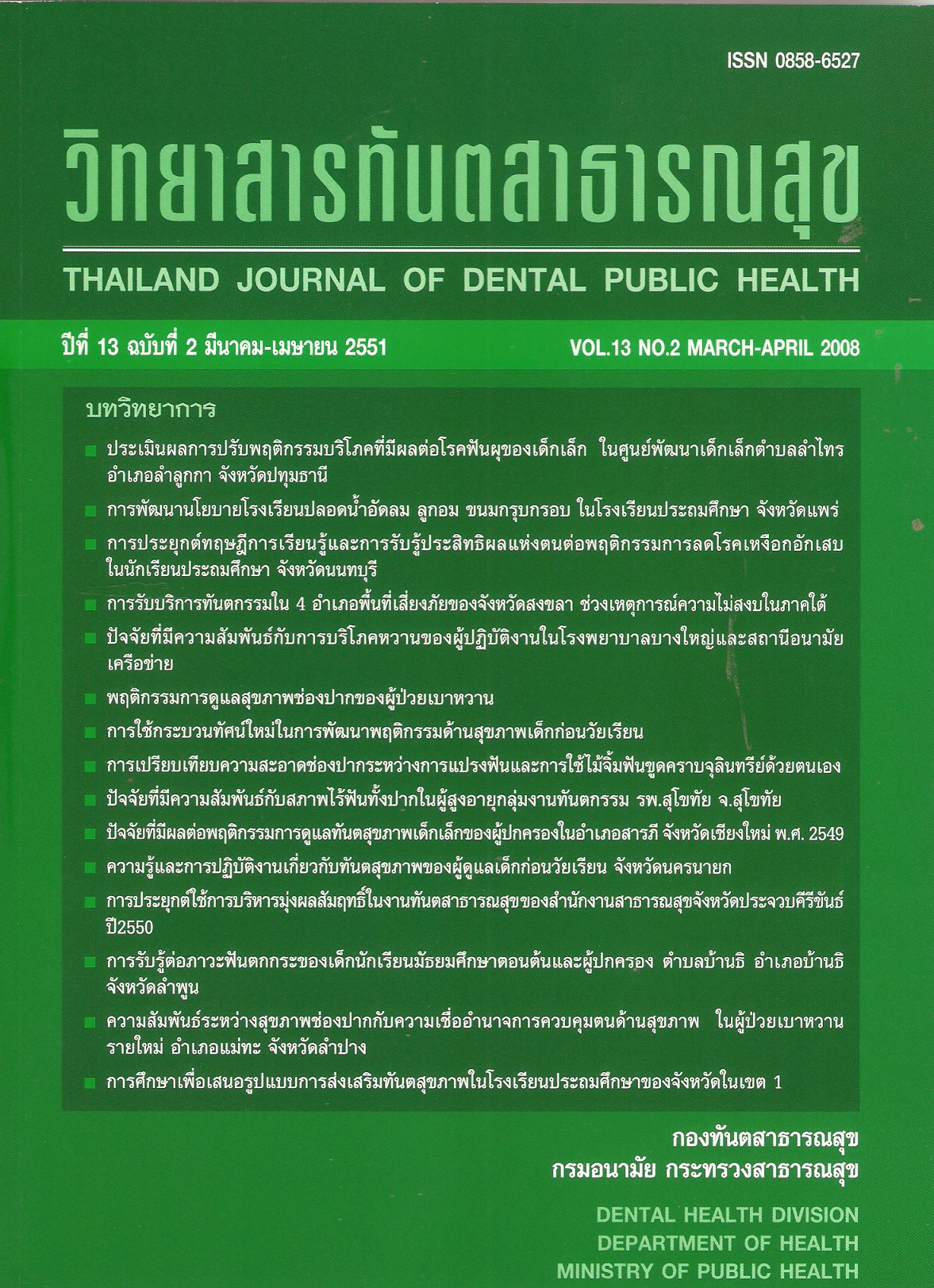Factors related to sweet consumption of Bangyai CUP health care workers.
Main Article Content
Abstract
This study aimed to investigate the knowledge attitude and practice that related to sweet consumption. The outcome of this study would be used to improve health care worker behavior shaping program. The target group consisted of 209 staffs who worked in Bangyai hospital and in health centers in Bangyai contracting unit for primary care (CUP) network. The questionnaire was tested for validity and reliability. Frequency, percentage, mean, standard deviation, Chi-square, and logistic regression were used to analyze data. The result revealed that 55.5% of the target group had moderate knowledge. 56% had good attitude towards decreasing sweet consumption program. 71.8% could practice moderately. The relationship study revealed that the factors that related significantly (p<0.05) were age, gender, marital status, childbearing, educational level, work experience, and attitude which related to behavior. The factors that did not related significantly were systemic disease, BMI (Body Mass Index), type of work, place of work, and knowledge about sweet consumption. There was no factor that significantly influenced sweet consumption behavior.
Downloads
Article Details
References
2. สํานักงานคณะกรรมการอ้อยและน้ําตาล กระทรวงอุตสาหกรรม รายงานการผลิตและจําหน่ายน้ําตาลในประเทศ พ.ศ.2547
3. ฤดี สุราฤทธิ์, น้ําตาล, พิมพ์ครั้งที่ 1 ออนพริ้นซ้อพ, 2549.
4. การเปลี่ยนแปลงรูปแบบการบริโภคที่มีผลต่อสุขภาพ ศึกษากรณีน้ําตาล ระหว่างปี 25042539 นายชาติชาย มุกสง นักวิจัยอาวุโส สํานักวิจัยสังคมและสุขภาพ สถาบันวิจัยระบบสาธารณสุข (สวรส.)
5. Newbrun E.Sugar and dental caries : a review of human studies Science, Vol 217, Issue 4558, 418-423.Copyright (c) 1982 by American Association for the Advancement of Science.
6. Rodrigues CS, Sheiham A. The relationships between dietary guidelines, sugar intake and caries in primary teeth in low income Brazilian 3-year-olds: a longitudinal study. Int J Paediatr Dent. 2000;10(1):47-55.
7. DuboisL,FarmerA,GiradM,Peterson K. Regular sugar-sweetened beverage consumption betweenmeals increases risk of overweight among preschool-aged children. J Am Diet Association, 2007; 107(6):924-34;discussion 934-5.
8. กรมอนามัย กระทรวงสาธารณสุข.มาตรฐาน น้ําหนัก ส่วนสูง และเครื่องชี้วัด ภาวะโภชนาการ ของประชาชนอายุ 1 วัน - 19 ปี คณะทํางานจัดทํามาตรฐาน น้ําหนัก ส่วนสูง และเครื่องชี้วัด ภาวะโภชนาการของประชาชนไทย; 2537.
9. มูลนิธิสาธารณสุขแห่งชาติ เครือข่ายวิจัย “โรคอ้วนในเด็ก” มัทนี เกษกมล (แปล),แม็คโครไบโอติคส์ สํานักพิมพ์สาระ, กรุงเทพ
10. Alok Bhargava and Aliaksandr Amialchuk. Added Sugars Displaced the use of vital nutrients in the national Food Stamp Program Survey. The American Society for nutrition, 2007. JNutr.137:453-60.
11. ชุดาภา จิตพิทักษ์ พฤติกรรมศาสตร์เบื้องต้น โครงการวิชาการ มูลนิธิมหาวิทยาลัยสงขลา นครินทร์, พิมพ์ครั้งที่ 2 สํานักพิมพ์กรุงเทพ: สารมวลชน, 2525.
12. วิณี ชิดเชิดวงศ์, การศึกษาเปรียบเทียบลักษณะนิสัยในการบริโภคและการเจริญเติบโตของเด็ก ก่อนวัยเรียนที่มาจากครอบครัวที่ต่างกันในจังหวัด นราธิวาส.กรุงเทพ: วิทยานิพนธ์ปริญญาโท,มหาวิทยาลัยศรีนครินทรวิโรฒ; 2521.
13. ทัศนีย์ เมธาคุปต์.อิทธิพลของครอบครัวที่มีผลต่อบริโภคนิสัยของเด็กก่อนวัยเรียนในตําบล ดอนคลัง อําเภอดําเนินสะดวก จังหวัดราชบุรี กรุงเทพ: วิทยานิพนธ์ปริญญาโท, มหาวิทยาลัยศรีนครินทรวิโรฒประสานมิตร; 2527.
14. วศินา จันทร์ศิริ ปัจจัยที่มีผลต่อการกินอาหาร เอกสารการสอนชุดวิชาอาหารและโภชนาการ ศาสตร์สาธารณสุข มหาวิทยาลัยสุโขทัยธรรมาธิราช. กรุงเทพ: รุ่งศิลการพิมพ์: 2526.
15. สุดาดวง เกรันพงษ์ มาตรการลดการบริโภคน้ําตาลเพื่อสร้างเสริมทันตสุขภาพ วารสาร วิชาการสาธารณสุข 2548 ; 14(4) :600-6.


